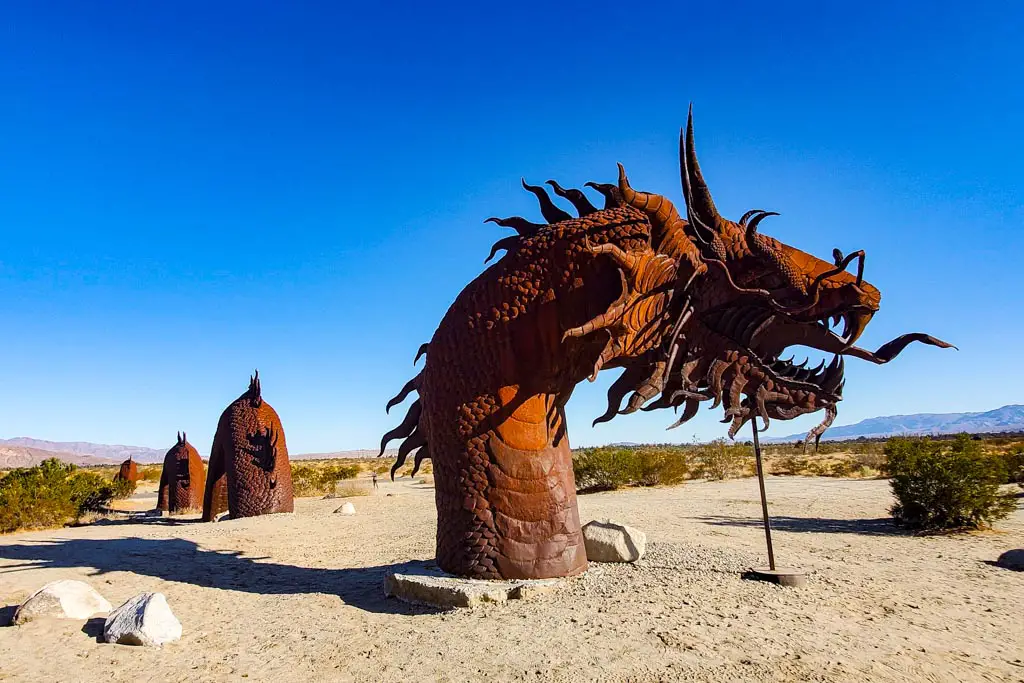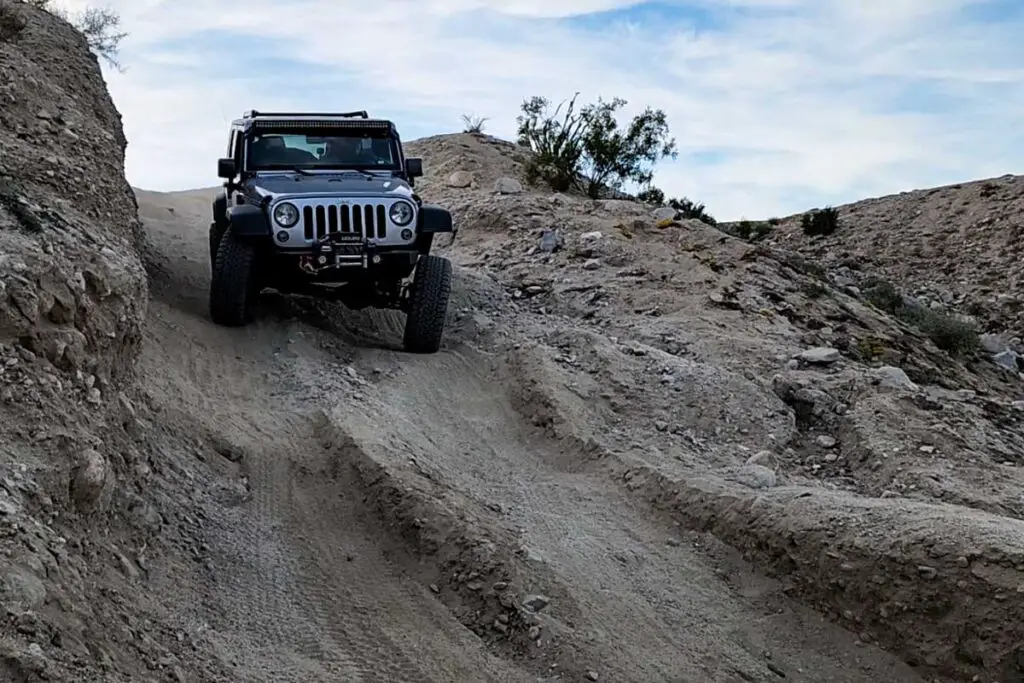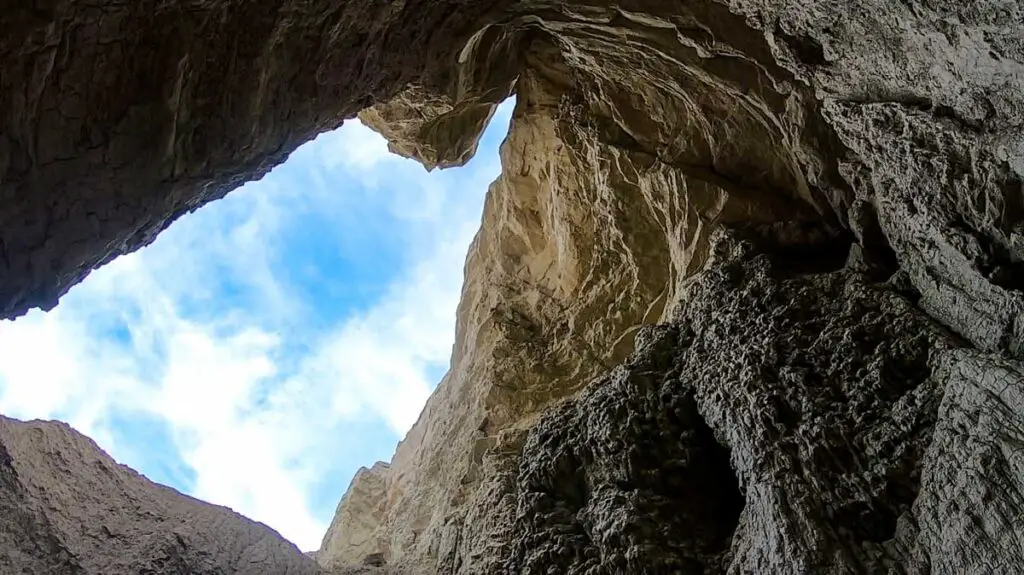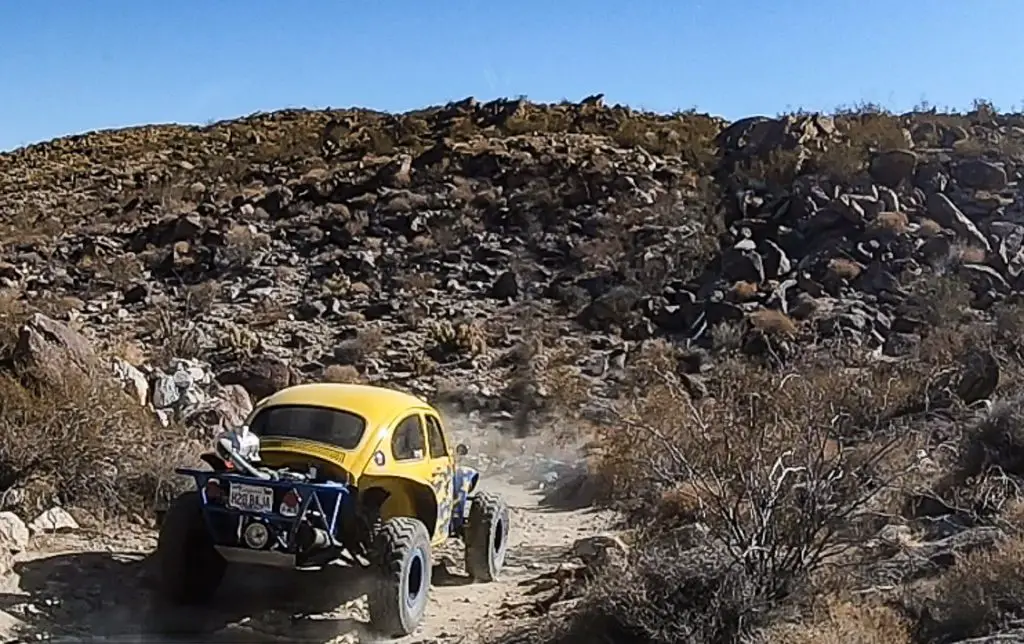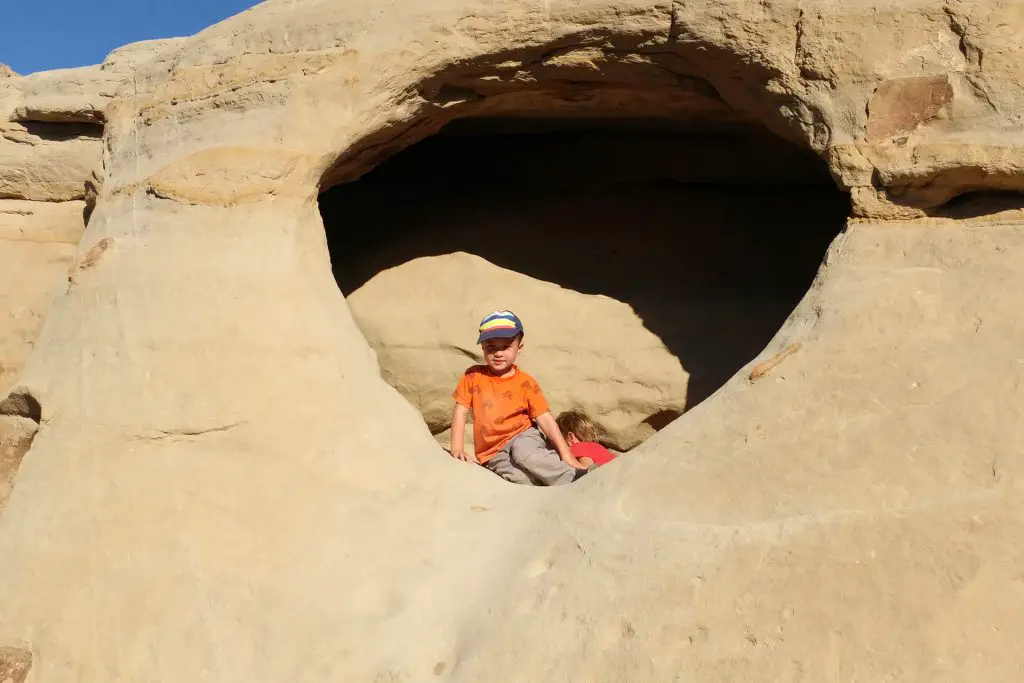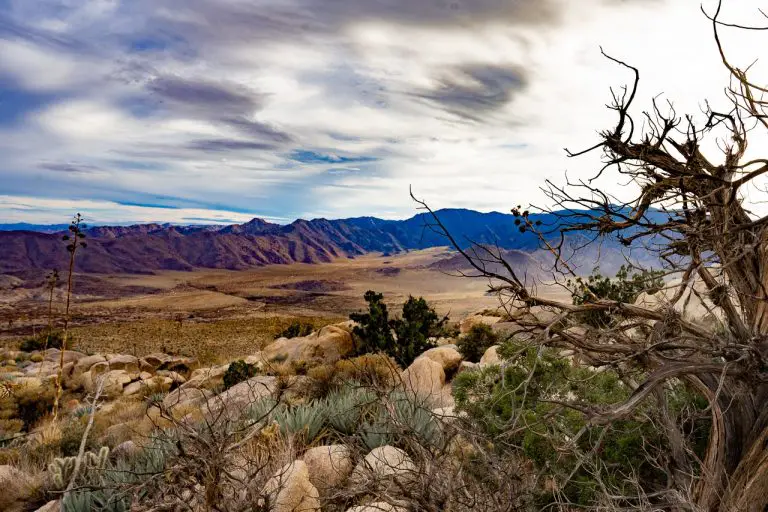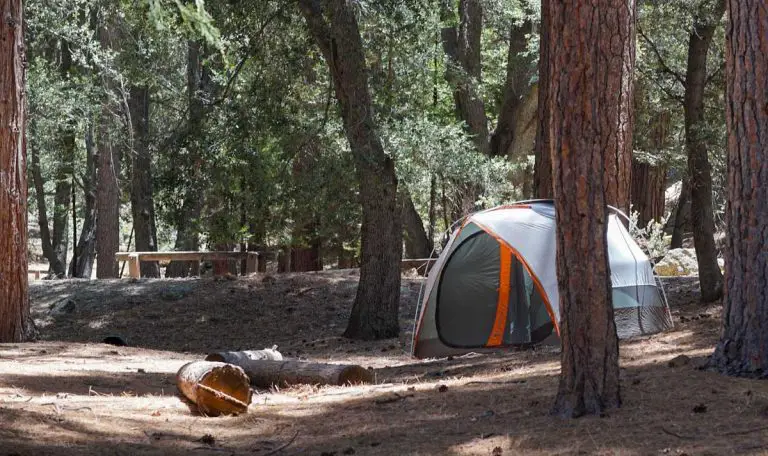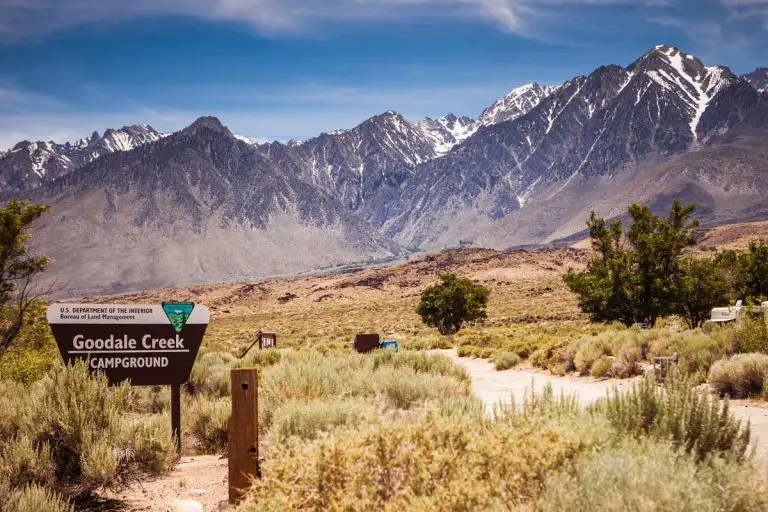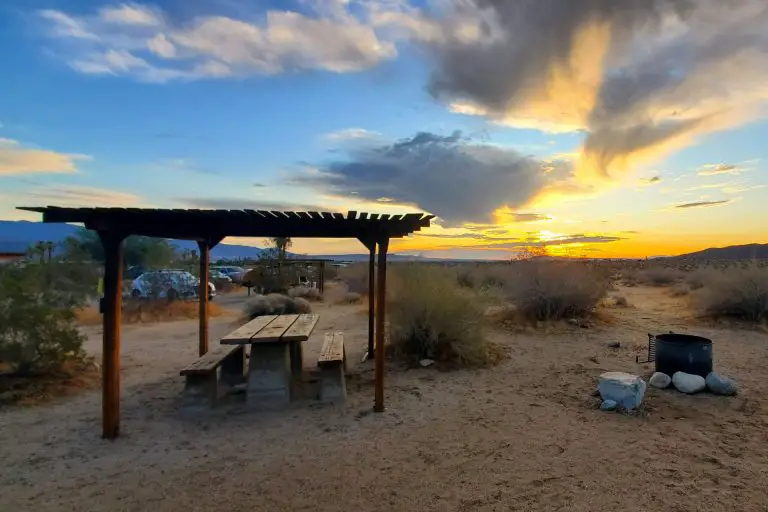Anza-Borrego Camping Guide
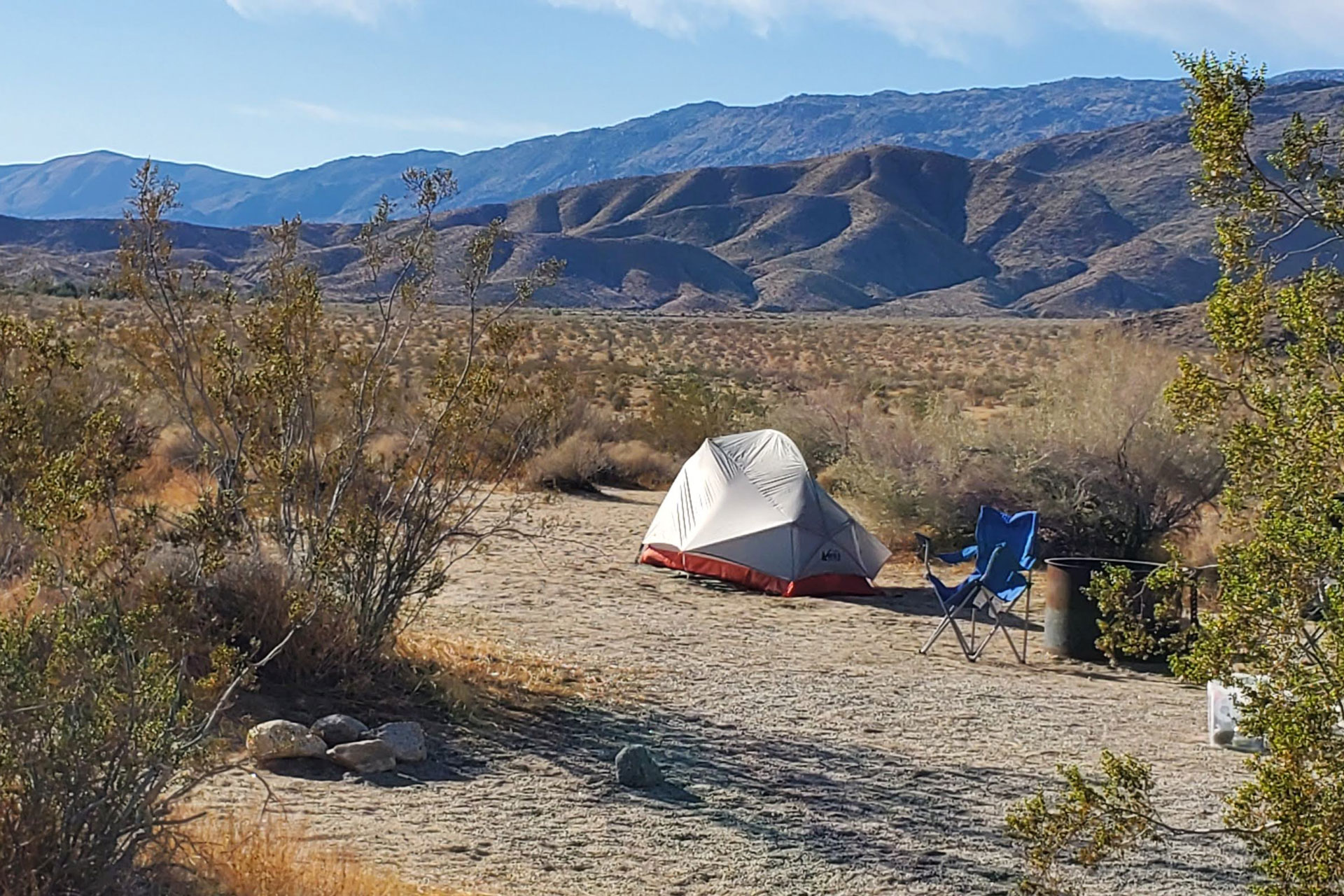
Anza Borrego Desert State Park, just two hours east of San Diego and three hours from Los Angeles, promises many avenues for adventure. The first challenge is finding accurate and complete information on Anza Borrego camping, which can be difficult to track down. This guide to the various developed campgrounds, primitive campsites, and dispersed camping opportunities should help jumpstart your plans to visit the park.
This Anza-Borrego camping guide augments our Ultimate Guide to Anza Borrego Desert State Park, a more general guide to Anza Borrego adventure, by offering more detailed information on camping in the park.
Check out our Desert Gear Guide for suggestions on camping equipment and other gear to make your desert adventures safer and more comfortable. If you are looking for trails, our guide to easy trails in Anza-Borrego is a good place to get started. Also, here is our video version of this Anza-Borrego camping guide.
The information in this guide is for informational purposes only. We use Gaia GPS for mobile devices and also bring high-quality printed topographic maps while in the backcountry, and recommend you do the same.
Anza Borrego Campgrounds In This Guide
Developed Campgrounds
- Borrego Palm Canyon Campground
- Tamarisk Grove Campground
- Vern Whitaker Horse Camp
- Bow Willow Campground
- Agua Caliente Campground
Primitive Campgrounds
- Arroyo Salado Primitive Campground
- Blair Valley Primitive Campground
- Culp Valley Primitive Campground
- Fish Creek Primitive Campground
- Mountain Palm Springs Primitive Campground
- Sheep Canyon Primitive Campground
- Yaqui Pass Primitive Campground
- Yaqui Wash Primitive Campground
Dispersed Camping
Overview of Anza-Borrego Camping
There are basically two ways to camp in Anza Borrego: 1) in established campgrounds, which come with varying degrees of amenities and cost, or 2) in dispersed camping areas, where you can set up camp where you like, in accordance with a few important rules and exceptions set by the state park system.
The first category, the established Anza Borrego campgrounds, range from a collection of ultra-basic primitive sites with a shared vault toilet and little else to highly developed campgrounds with showers, flush toilets, RV hookups, and even cabins for rent.
The second category, disperse camping where no formal campground is established, can be either car camping near one of the park’s many dirt roads or getting away from roads to camp further into the desert wilderness.
Some areas of the park are closed (whether permanently, temporarily, or seasonally) to disperse camping to conserve or restore the fragile desert ecosystem. Note: Since there are no ground fires allowed in dispersed camping areas, you’ll need to bring a camping fire pit with you if you want a campfire.
Established Anza-Borrego Campgrounds
California State Parks manages a dozen established campgrounds in Anza Borrego Desert State Park. These include eight primitive, first-come, first-served campgrounds, which are free but offer few amenities, and four developed campgrounds that offer more amenities, to varying degrees.
Three of these, Borrego Palm Canyon Campground, Tamarisk Grove Campground, and Vern Whitaker Horse Camp can be reserved online at ReserveCalifornia.com or by phone at 760-767-5311. The park service charges day-use fees for all of the developed campgrounds: Borrego Palm Canyon, Tamarisk Grove, Bow Willow, and Horse Camp campgrounds.
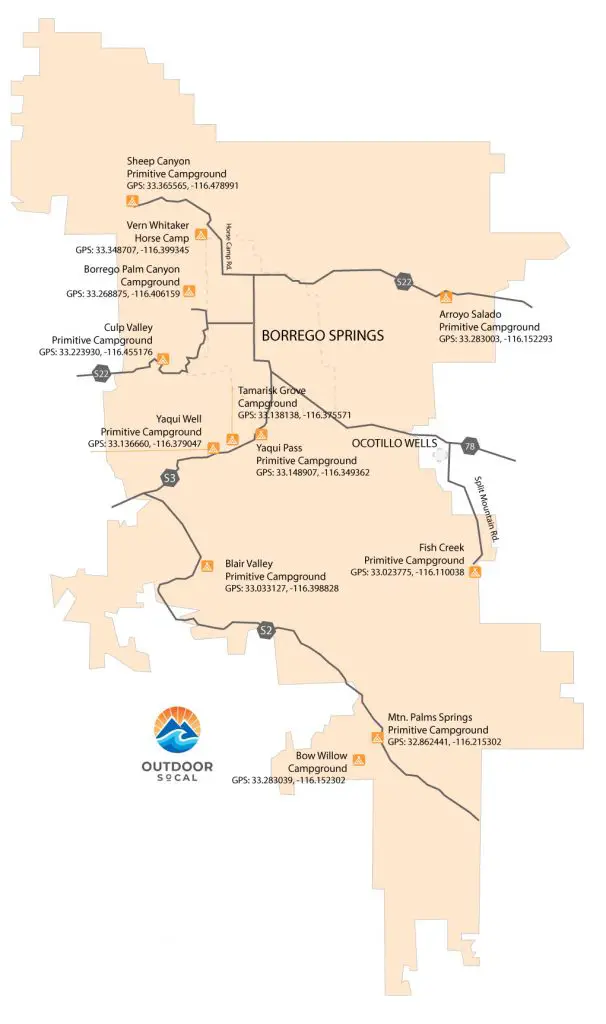
Developed Anza-Borrego Campgrounds
1) Borrego Palm Canyon Campground
Borrego Palm Canyon Campground is located just west of the town of Borrego Springs (GPS: 33.268713, -116.406073) and offers easy access to Borrego Palm Canyon Trail, Panoramic Overlook Trail, and the state park visitor’s center. This is the closest campground to a town, offering the added bonus of access to Borrego Spring’s restaurants and stores.
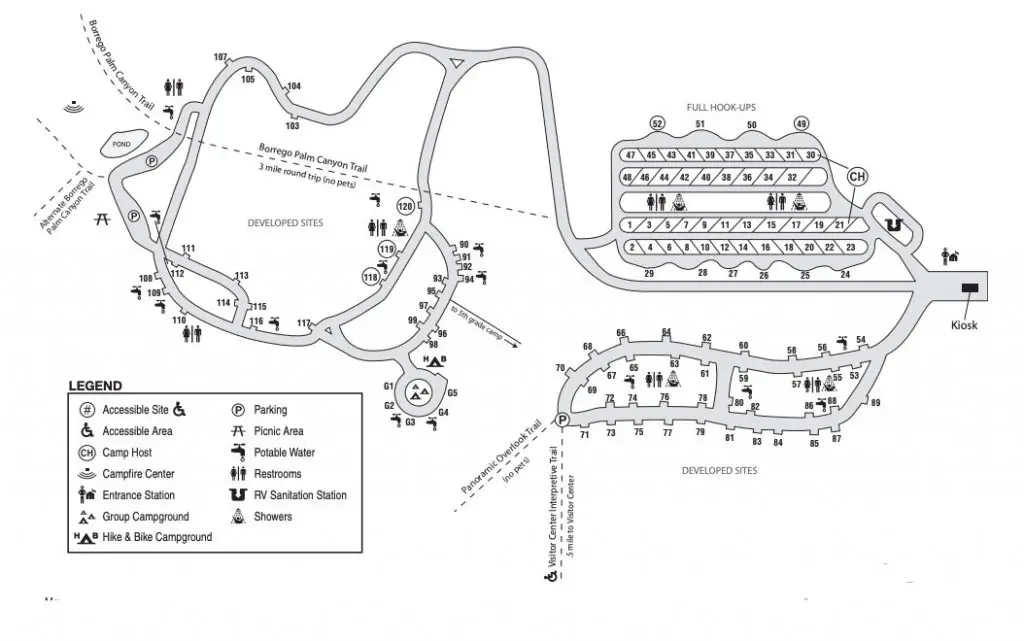
From October 1 – April 30, the campground takes reservations, which can be made online at ReserveCalifornia.com. It is divided into three sections. Two of the sections offer tent and RV camping, with no hookups. The third section offers full hookups and requires that an RV be present before campers can pitch additional tents.
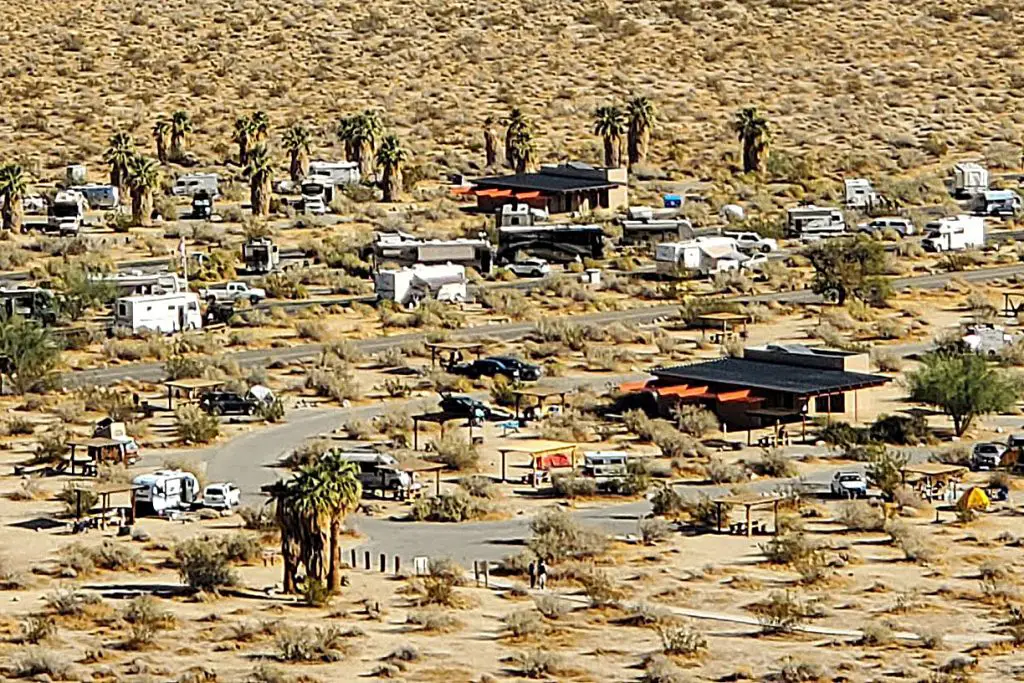
The campground offers potable water, toilets, coin-operated showers, picnic tables, and fire pits, among other amenities. The trailhead for the popular Borrego Palm Canyon Trail is located on the north end of the campground. A day-use fee is required to park and hike the trail.
For more information, visit our guide to Anza Borrego Palm Canyon Campground
2) Tamarisk Grove Campground
As you head into Anza Borrego from the mountain town of Julian on Route 78, Tamarisk Grove Campground is the first developed camping area you’ll encounter (GPS: 33.138502, -116.375072).
Located at the split of the 78 (which heads east towards the town of Ocotillo Wells) and S3 (which winds northeast over Yaqui Pass towards Borrego Springs), the campground, comprising 27 campsites, is well situated near the center of the park.
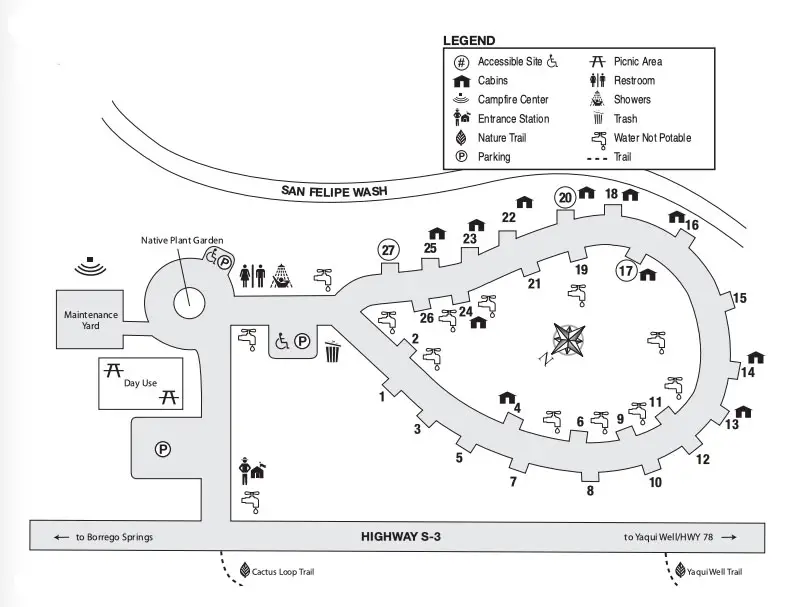
Tamarisk Grove is part of a cluster of Anza Borrego campgrounds, that also includes Yaqui Pass and Yaqui Wash primitive campgrounds. If you can’t get a reservation at Tamarisk Grove, these primitive campgrounds can be a good alternative (see below for more info on them).
For more information, see our complete guide to Tamarisk Grove Campground.
3) Vern Whitaker Horse Camp
Vern Whitaker Horse Camp, located about 4 miles north of Borrego Springs, is a great home base for exploring the northern parts of Anza Borrego on horseback (GPS: 33.348720, -116.399432). Reserved for equestrians, this campground offers 12 developed campsites for RVs or tents and offers around 40 horse corrals. The campground is open all year round, but peak season is during the cool(er) months, October to April.
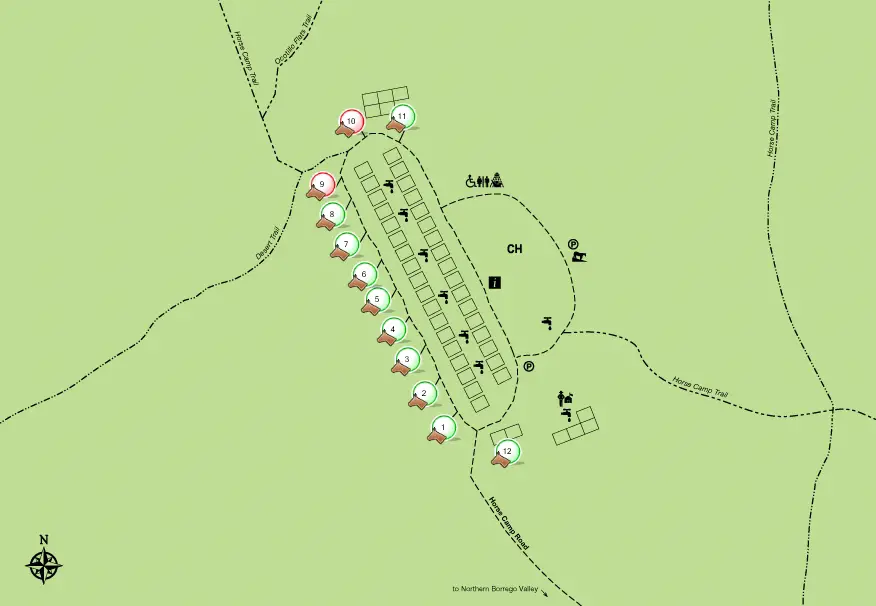
The campground is situated in a secluded desert valley at the intersection of over 30 miles of equestrian trails, including Horse Camp Trail, Desert Trail and Ocotillo Flats Trail. Amenities include potable water, restrooms and coin-operated showers. The campground can accommodate trailers up to 35-feet in length.
4) Bow Willow Campground
Located in the quite, southernmost portion of Anza Borrego, Bow Willow Campground offers no-frills camping at the foot of low hills with a sweeping view of the open desert. The campground includes 16 first-come, first-served campsites. Amenities include potable water, picnic tables, fire rings, shade ramadas and vault toilets. Of the “developed” campground in Anza Borrego, it is the most rustic.
The campground is located at the end of Bow Willow Road, 1.6 miles from its intersection with the Southern Emigrant Trail (S2). The campground is on the site of an ancient seasonal Kumeyaay Indian village, at the mouth of a wide wash (GPS: 32.842331, -116.225717). A number of trails intersect here. These include a trail the Kumeyaay used to take to get to the Laguna Mountains, and trails to Rockhouse Canyon, Mountain Palms Springs Campground, and Torote Bowl. This is a good campground for getting away from the more heavily trafficked northern portions, while still having some basic infrastructure.
5) Agua Caliente Campground
While it’s managed by San Diego County and not officially part of the state park, Aqua Caliente Campground is surrounded by Anza-Borrego and is terrific base for exploring the desert (GPS: 32.949283, -116.303460).
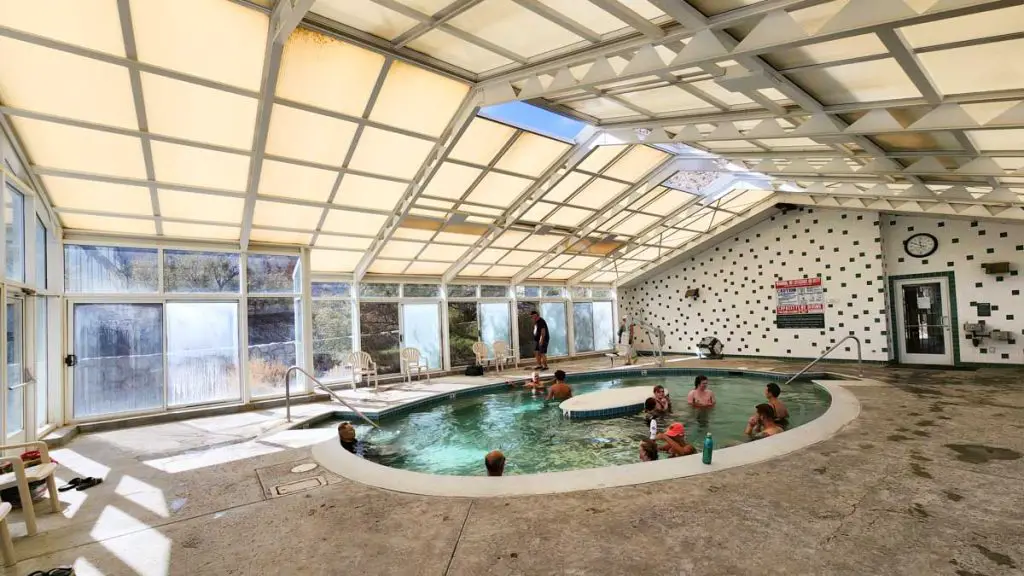
Located in the central area of Anza-Borrego, the campground is known for its geothermally heated springs, which feed three pools within the campground. Two are outdoors and one, for adults only, is indoors. The campground has 140 campsites, many with partial or full hookups, and offers cabins for rent. For more information, visit our detailed guide to the campground.
Primitive Anza Borrego Campgrounds
The park service has established the following rules for primitive and dispersed camping in the park:
- Your vehicle can only be one car length from the road — although you can hike away from the road to set up camp.
- Do not trample on vegetation or drive over geological features.
- You must camp at least 100 yards from any water source.
- Ground fires are not permitted, so bring a camping fire pit if you want a campfire.
- Bring your own firewood and take your cooled ashes with you; gathering or taking of any live, dead, or downed vegetation is prohibited.
- Pack out all of your garbage, including toilet paper and human waste.
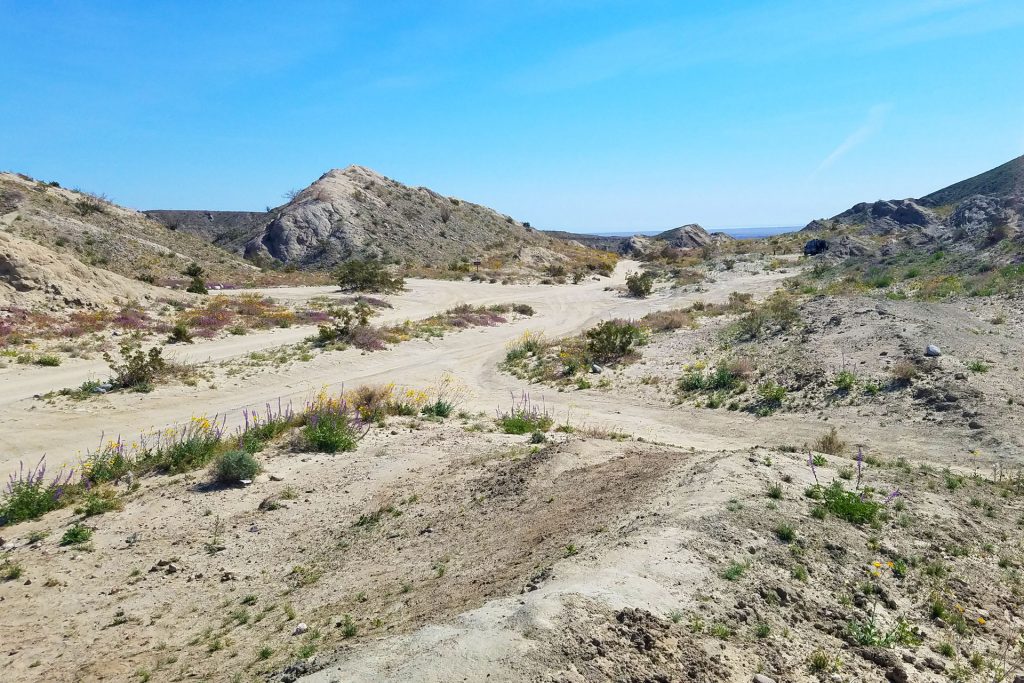
Anza Borrego’s primitive campgrounds are designated first-come, first-served camping areas that offer few if any amenities. Camping is free. In some cases, distinct sites are demarcated by stones and fire rings, while other campgrounds allow you to camp wherever you’d like to pitch a tent or park your RV. Fires are prohibited outside of official fire rings, to avoid scarring the slow-to-heal desert soil. Bringing a fire pit with you is another good option.
5) Arroyo Salado Primitive Campground
Arryo Salado Primitive Campground is conveniently located (GPS: 33.283053, -116.152286) just off Borrego Salton Seaway (Highway S22), near the entrance to the Calcite Mine Trail and Truckhaven Trail (which can be accessed with a 4-wheel-drive from the dirt road that runs through the campground). Ocotillo Wells Off-Highway Vehicle Area, a popular offroading destination, is a few miles east of the campground.
Amenities are limited to a couple of vault toilets, and there are no formal campsites or fire rings, so you’ll need to bring a fire pit if you want a campfire. This is a great place to camp if you don’t have a reservation at one of the developed campgrounds but like the idea of having a toilet available.
6) Blair Valley Primitive Campground
Blair Valley Primitive Campground is a great base for exploring Blair Valley and Little Blair Valley, two quiet, undeveloped valleys nestled in the mountainous western portion of Anza Borrego south of Borrego Springs. The campground is situated at an elevation of about 2,500 feet (GPS: 33.033037, -116.399311), off Highway S-2, down Little Blair Valley Road (take the southernmost of the roads two entrances from the S2).
The campground offers dispersed camping and a single vaulted toilet. Further south and east on the road is the trailhead for a 1.8-mile out-and-back trail that ends near rocks where ancient Kumeyaay Indians drew pictographs thousands of years ago.
7) Culp Valley Primitive Campground
Culp Valley Primitive Campground (GPS: 33.221990, -116.457339) sits at the highest elevation of any of Anza Borrego’s campgrounds, located at 3,500 feet in the San Ysidro Mountains west of Borrego Springs off Montezuma Valley Road (S22). This is a popular destination for Anza Borrego camping, as it’s the first campground Anza Borrego visitors reach as they head to the desert from the northeast. The location offers dispersed camping and vaulted toilets.
Just across the S22 from the campground is a popular climbing area called Windy Boulders for the regular winds that blow through Culp Valley. Culp Valley Trail, an easy half-mile hike that begins at the campground brings you to an overlook of Borrego Valley. This can be combined with other trails in the area to form a loop that brings you to Culp Valley Overlook and Peña Springs.
8) Fish Creek Primitive Campground
Fish Creek Primitive Campground is located in the eastern portion of Anza Borrego Desert State Park, south of Ocotillo Wells (GPS: 33.023780, -116.110039). It’s a great base from which to explore nearby Split Mountain Gorge, the Anza Borrego Wind Caves, and the Fish Creek-Vallecito Badlands. The campground offers vault toilets, fire rings, and six loosely defined campsites. You can also camp outside of the defined sites, but you’ll need your own fire pit if you want a campfire.
To get there, get off Route 78 in Ocotillo Wells onto Split Mountain Road and travel about 8 miles south to where the road splits off on the right to Fish Creek Wash. Fish Creek Campground is on the left after 1.4 miles. The campground sits on a rise above Fish Creek Wash near the entrance of Split Mountain Gorge.
9) Mountain Palm Springs Primitive Campground
Mountain Palm Springs Primitive Campground is located at the foot of the Tierra Blanca Mountains in the southern portion of Anza Borrego, about a mile north on the S2 from the turn off for Bow Willow Campground (GPS: 32.862777, -116.215086).
The campground offers vault toilets and dispersed camping, but no fire rings, so you’ll need to bring a fire pit if you want a fire. Pay particular attention to avoid the many Cholla Cactus that grow in abundance around the campground, especially if you have dogs or kids with you. The thorns are brutal.
The Mountain Palm Springs Trail, which starts at the campground, offers a 2.5-mile loop that brings you to several nearby desert palm groves, each offering an oasis for hikers. You can also hike to Bow Willow Campground from here, or follow trails that go further into the mountains.
10) Sheep Canyon Primitive Campground
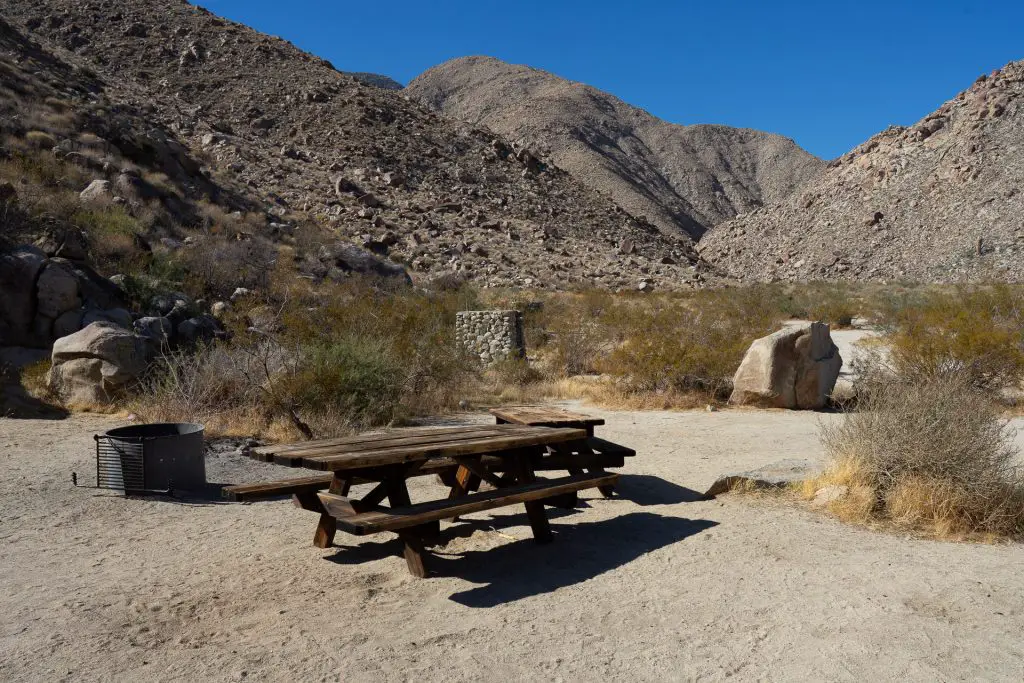
Sheep Canyon Primitive Campground is the most isolated of the developed campgrounds in Anza Borrego, requiring a long hike in or a high-clearance 4-wheel-drive vehicle to reach it (GPS: 33.365565, -116.478998). This remote campground is the northernmost of the developed campgrounds, located just past the confluence of two stream-filled canyons, Sheep Canyon and South Fork Sheep Canyon. Note that the park service closes this area, more generally known as Coyote Canyon, during the summer months, as the streams are important water sources for the indigenous bighorn sheep. It’s worth checking with the visitor’s center (760-767-5311) before planning a trip here. There is a $10 per night fee for camping in Sheep Canyon (at the time that we’re writing this).
The campground offers a few defined sites with fire rings, and many other options for dispersed camping (you’ll need to bring a fire pit for those sites). The campground also offers vault toilets. Like the rest of the primitive campgrounds in Anza Borrego, there are no trashcans, so you’ll need to pack out your trash.
There are many nearby hiking trails. Sheep Canyon offers a steep two-mile hike to a terrific overlook. South Fork Sheep Canyon offers a more difficult trail that brings you to a 30-foot waterfall. Several nearby canyons such as Cougar, Indian, and Salvador canyons also offer hikes along streams and other waterfalls to discover.
11) Yaqui Well Primitive Campground
Yaqui Well Primitive Campground is located along Yaquie Well Road just west of Tamarisk Grove Campground off Highway S3, a mile from the fork at Highway 78 (GPS: 33.136661, -116.379041086). This campground offers disperse camping with vault toilets, but no other amenities. The toilets are located just under half a mile along Yaqui Wells Road from the S3. There are no fire rings, so bring a fire pit if you want a campfire.
Yaqui Well Trail, a 1.6-mile out-and-back trail that begins just across the road from Tamarisk Grove Campground. It parallels Yaqui Pass Road, on its north side, and is easily accessible from the campground. It brings you to Yaqui Well, a small seep that is a great spot to view desert birds. The well is only about a quarter of a mile from the campground toilets. Cactus Loop Trail, just across Highway 78 from Tamarisk Grove Campground, is another nearby hike.
12) Yaqui Pass Primitive Campground
Yaqui Pass Primitive Campground is located in Yaqui Pass east of Tamarisk Grove Campground, off Highway S3 as crosses the mountains into Borrego Springs.
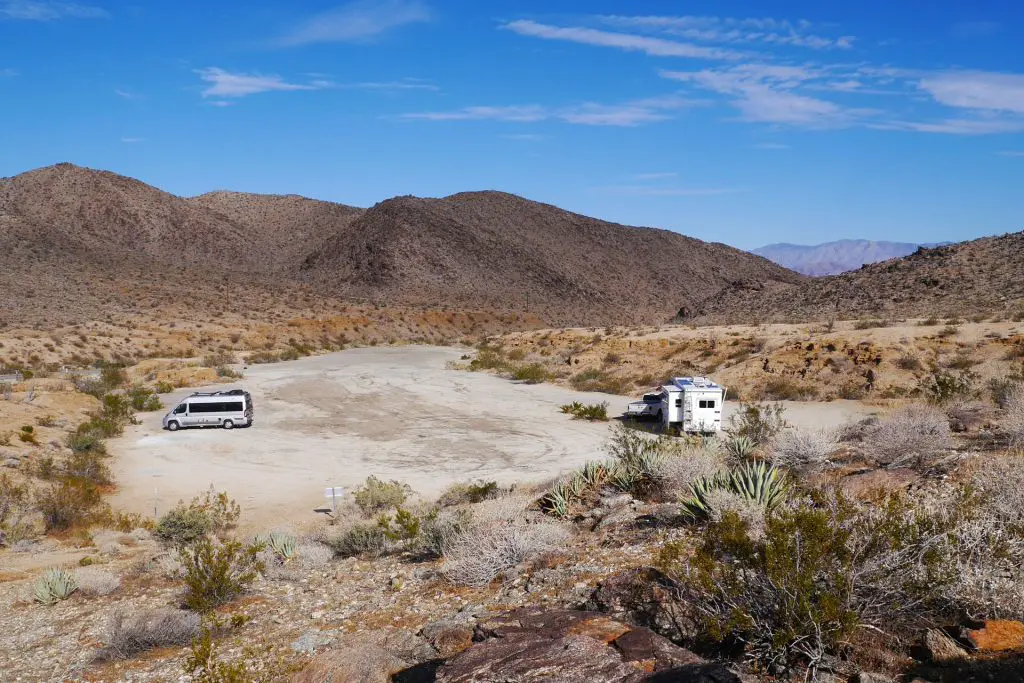
This campground offers dispersed camping with no amenities, but is a good place to camp in an RV, as it is covered with gravel and fairly flat–basically a giant parking lot. There are no restrooms, so you’ll need to make arrangements.
For more information, visit our detailed guide to Yaqui Pass Primitive Campground.
Dispersed Anza Borrego Camping
If you can’t find a site in one of the established campgrounds or just want to find more solitude, there are plenty of options for free dispersed camping in Anza Borrego. Some dispersed camping areas are relatively popular and you may well encounter other parties of campers. Look hard enough, though, and you can find an isolated site to yourself.
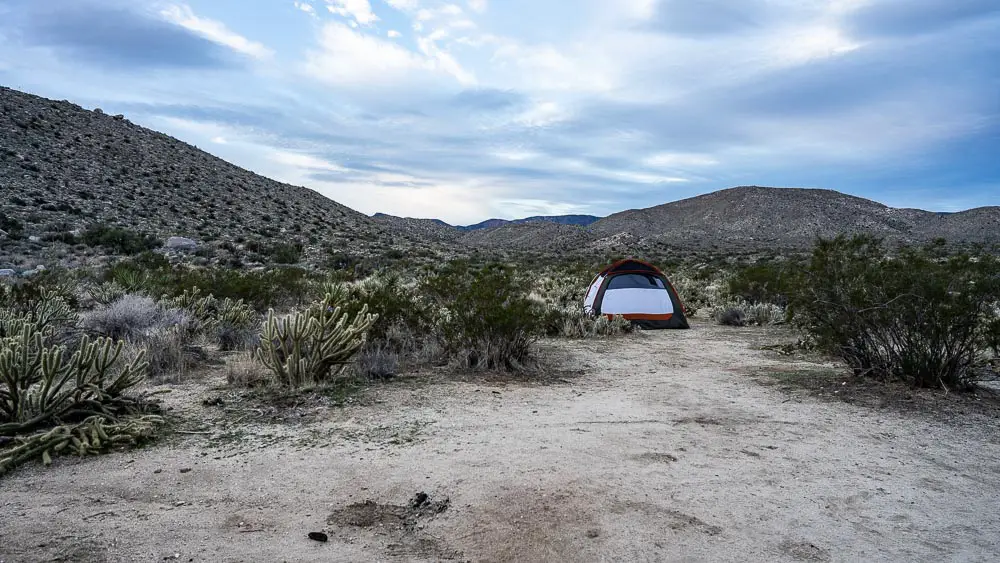
The rules for primitive campsites, listed above, also apply to dispersed camping. It’s worth taking particular note of the rules about parking only a car length from the road, bringing your own fire pit, and carrying out trash, toilet paper, and human waste.
Beyond car and RV camping, backpackers can camp along any of the park’s trails, with the exception of areas that may be closed by the State Park for conservation reasons — for instance, to protect bighorn sheep water areas. It’s a good idea to check with the visitor’s center to get up to date information on backcountry camping in the park.
Here are a few ideas for dispersed camping (with a focus on car/truck and RV camping):
Blair Valley
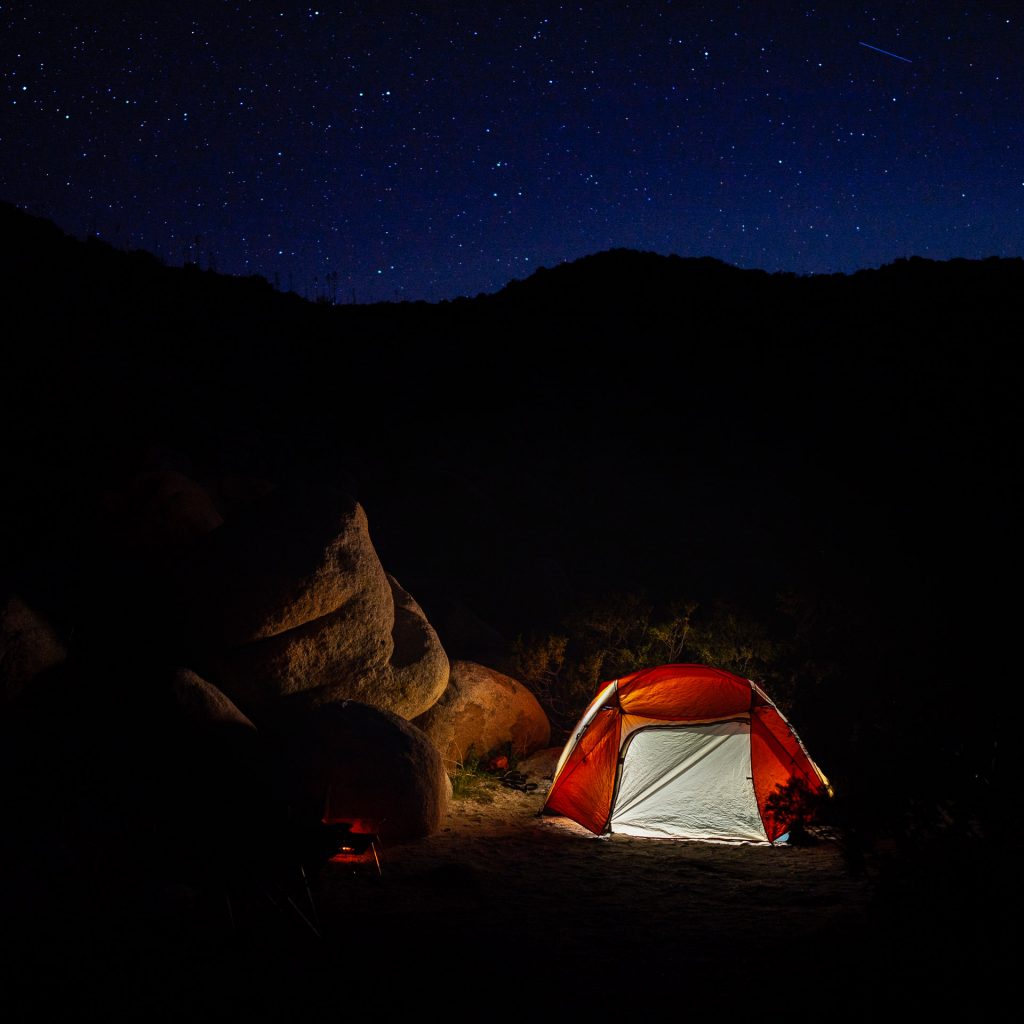
Blair Valley and Little Blair Valley offer many spots for dispersed camping, beyond the established Blair Valley Primitive Campground outlined above. Both valleys, which are separated by a rocky ridge that runs north to south, are the sites of a dry lake bed. This makes them quite flat, which a plus if you are camping in an RV. There is a maze of roads off the main road that loops through the valleys, particularly near the ridge, and any of these can serve as a camping spot (if you are in an RV, you will want to check the road conditions of these side roads before you find yourself stuck in sand or mud).
Our guide to Blair Valley goes into more detail on campsites and hiking trails.
Coyote Canyon
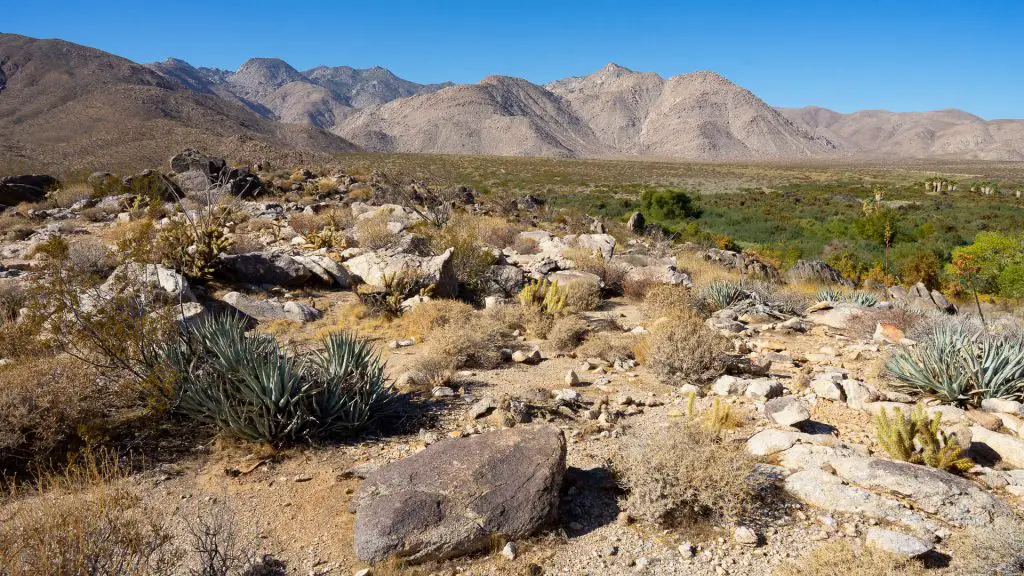
Coyote Canyon Coyote, located northwest of Borrego Springs and accounting for about a sixth of Anza-Borrego Desert State Park, is another secluded area that’s great for dispersed camping. If you can’t find a site at Sheep Canyon Primitive Campgrounds, you can look for other areas to camp off of the road that runs through Coyote Canyon.
A four-wheel drive and high clearance are necessary to access the deeper parts of Coyote Canyon by vehicle, as the road into the canyon becomes gnarly at the first creek crossing during periods of high water. For more information, visit our guide to Coyote Canyon.
Check back, we will continue adding suggestions for dispersed camping.
Getting to Anza-Borrego Desert State Park
Anza Borrego Desert State Park is located in eastern San Diego County, with portions of the park bordering Riverside County. The park is located about 2 hours drive from San Diego and 3 hours from Los Angeles. There are multiple ways to approach the park from San Diego, but entering from the I8 on the south side or via Highway 78 through the town of Julian are popular routes. From Los Angeles and the Inland Empire, the I15 to Highway 79 to Montezuma Valley Road (Highway S22) is a common approach.

